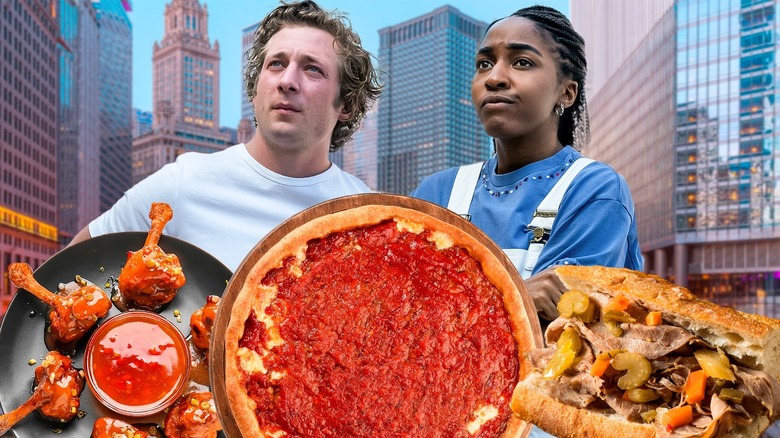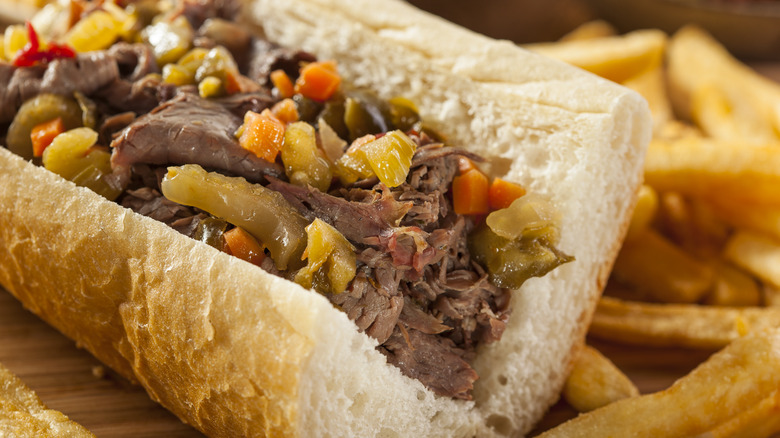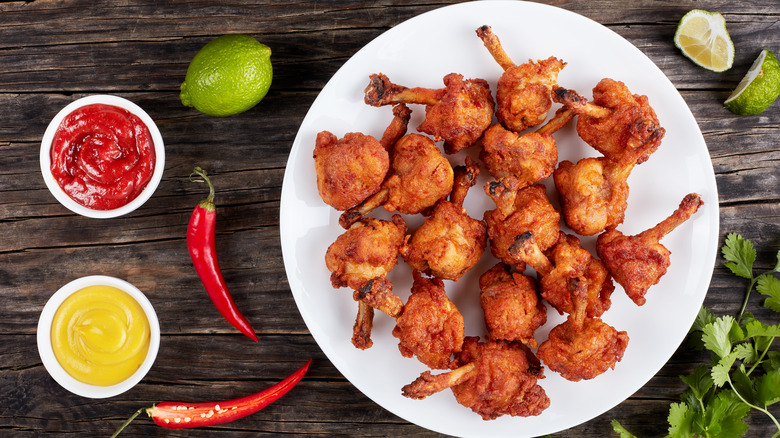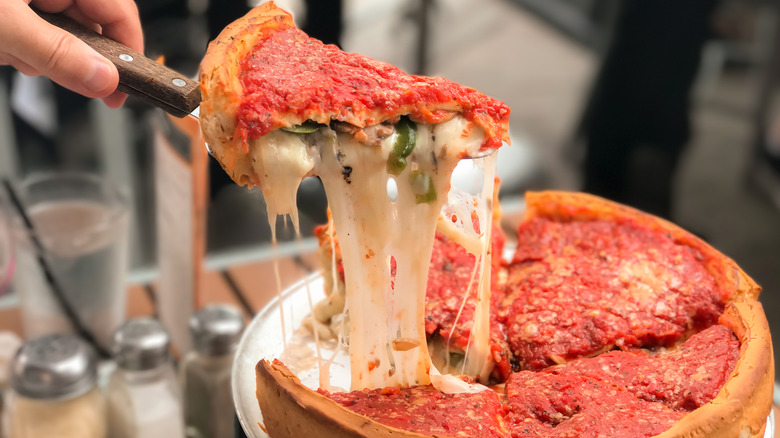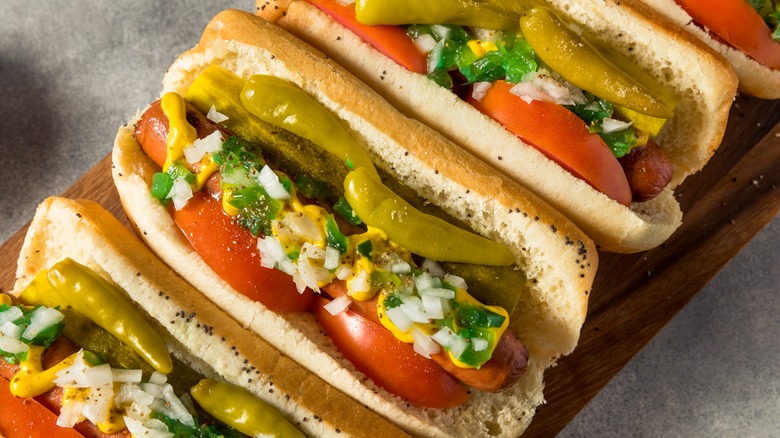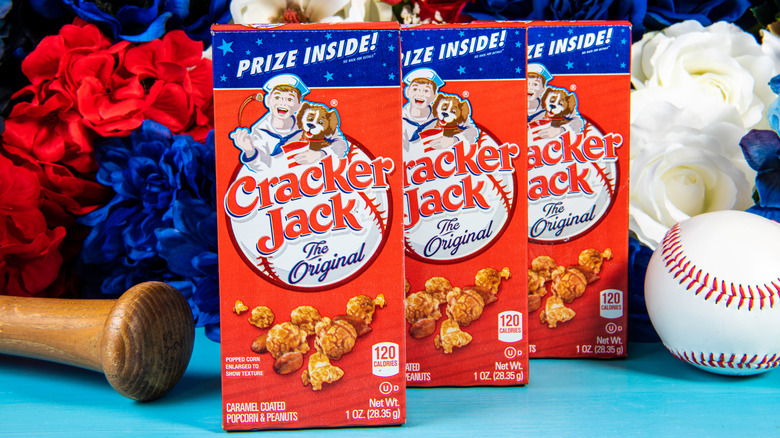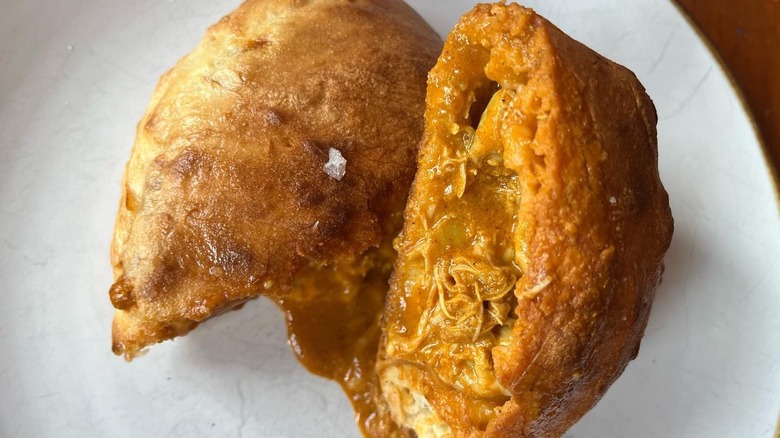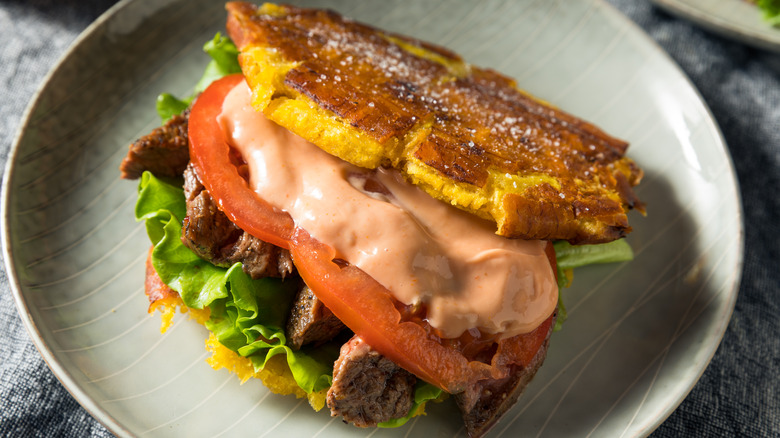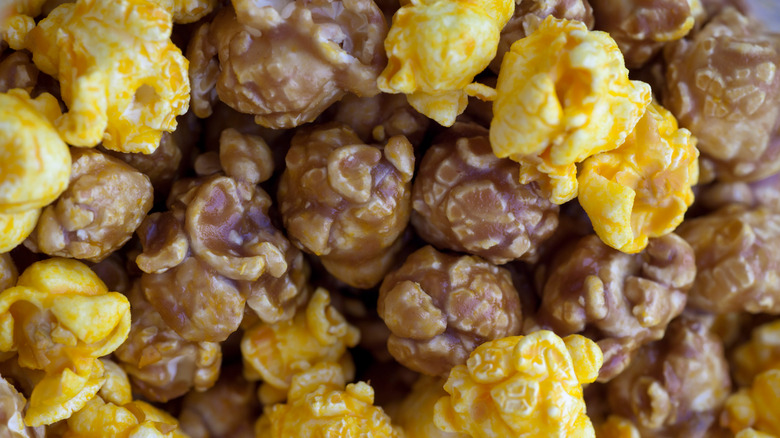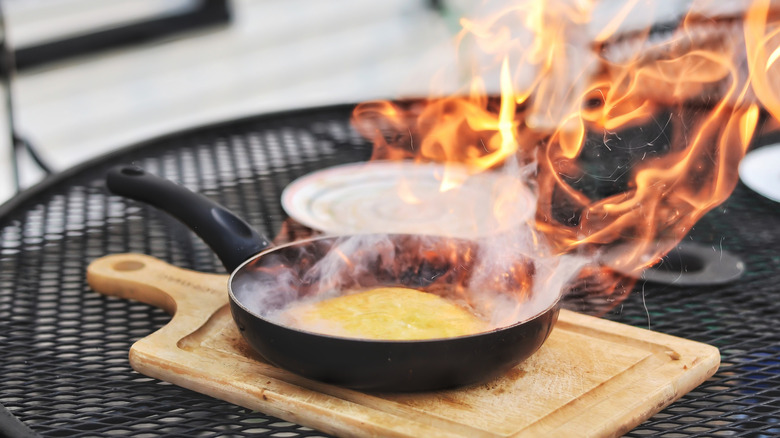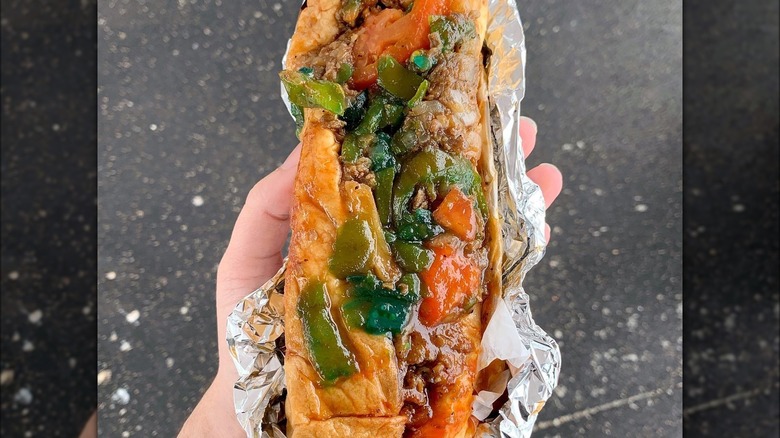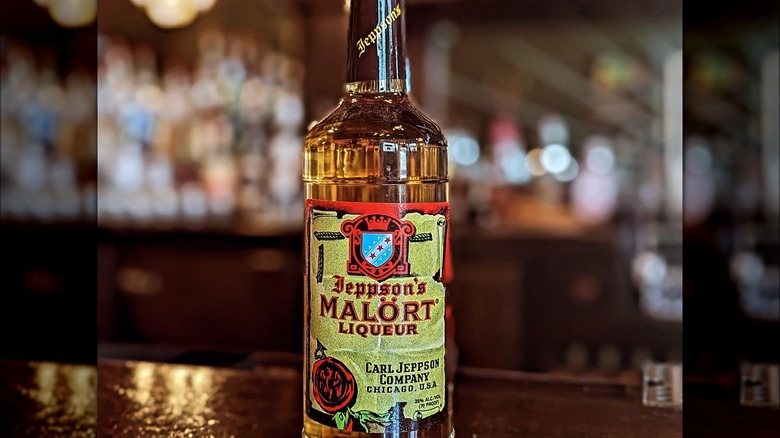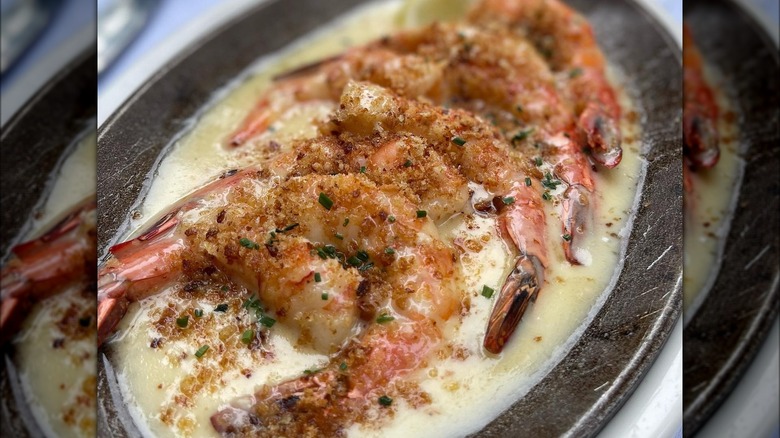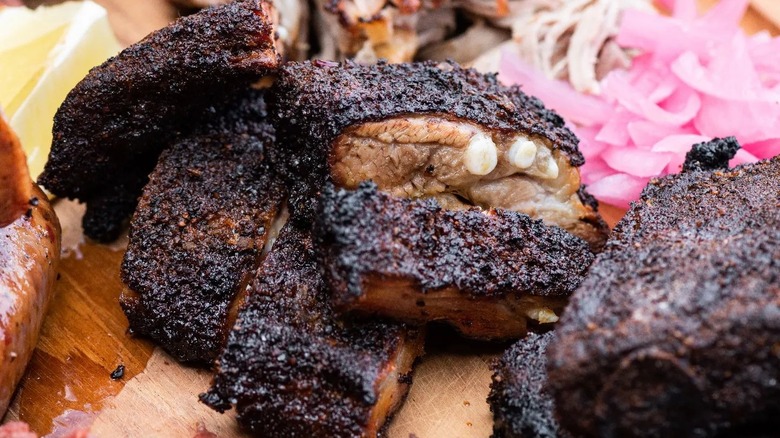Watching The Bear Season 3 Is Even Better With These Chicago-Inspired Foods
If you're already getting amped about Season 3 of "The Bear," you're not alone. According to The Walt Disney Company (owner of Hulu) "The Bear" Season 2 broke records when it became the most-watched FX show on Hulu. Season 3 will drop on June 27, 2024, and you can bet thousands of fans will be streaming it to see what unfolds for Carmy (Jeremy Allen White), Sydney (Ayo Edebiri), and the rest of the crew at the newly revamped and re-opened restaurant, The Bear. Based on the previous seasons, we're sure there will be tons of trials, tribulations, and emotional upheavals.
Even with all the anxiety-inducing chaos cooking going on in the show (or perhaps precisely because of that), it's hard to watch "The Bear" and not crave some of the dishes featured. According to The New York Times, after the show launched in 2022, it sparked a Chicago beef boom with people flocking to restaurants in search of Italian beef sandwiches. If you're looking for some dishes that will transport you to the Windy City, these are a few classic Chicago foods you can snack on while watching "The Bear" Season 3.
Italian beef sandwich
As any fan of "The Bear" knows, the Italian beef sandwich was the signature dish of The Original Beef of Chicagoland. While it remains to be seen whether the sandwich will remain on the menu at The Bear now that there's more of a fine-dining focus, it will always be part of its roots and Chicago's. According to Red Sauce America, the sandwich was created by Italian immigrants who worked in Chicago's Union Stockyards. The workers would bring home tough cuts of beef and braise them, thinly slice the meat, and eat it in sandwiches.
There are several ways Italian beef sandwiches differ from other roast beef sandwiches. First, the beef is bathed in beef jus before being added to the sandwich. Some cooks also dip the whole sandwich in the gravy. In addition, the bread must be a French roll. Finally, the sandwich is topped with sweet peppers and giardiniera (pickled vegetables). If you happen to be in Chicago, some of the best Italian beef sandwiches that bring "The Bear" to life can be found at Al's #1 Italian Beef (the original Italian beef sandwich spot) and Portillo's.
Lollipop chicken wings
If you're planning a viewing party for Season 3 of "The Bear," lollipop chicken wings are the ultimate party snack. These tasty treats consist of chicken wings that have been cut so that the meat slides down to one end of the bone. They're deep-fried or baked with the bone in and tossed in sauce. The bone makes for the perfect handle to grab a wing and devour the tender, sauce-slathered meat with less mess than your typical chicken wing.
The world can thank Chicago for lollipop chicken wings. The creator was a man named Nai Tiao, who drew inspiration from a Korean dish called gam pong gi to create the wings. Tiao adapted the dish, cutting the wings lollipop style and slathering them in a sweet chili sauce. You can still sample his famous lollipop chicken wings at Great Sea Restaurant today. The dish is so popular that many have created copycat recipes, including celebrity chefs like Guy Fieri and Gordon Ramsay. You can create your own at home with any store-bought sweet chili sauce. We also highly recommend BBQ chicken lollipops with a tangy, smoky barbecue sauce.
Deep-dish pizza
One of Chicago's most iconic dishes is the beloved deep-dish pizza. Unlike many other pizza styles you'll find across the country, these unique pies are cooked in deep cast-iron or steel pans. The pan is oiled before a thick layer of dough is pressed into it. Then comes a layer of cheese, a layer of meat and veggies, and finally a topping of tangy tomato sauce. The result is an ultra-tall pizza with a crunchy crust and an over-the-top cheesy, meaty filling.
The first deep-dish pizza was created at Pizzeria Riccardo (later named Pizza Uno) on Chicago's North Side in the early 1940s. According to America Domani, owners Ike Sewell and Ric Riccardo wanted to create a pizza that stood out from the thin-crust versions that were being served at taverns around town. Their solution was a massive pie packed with tons of toppings. The dish eventually took off and even spawned another Chicago creation: the stuffed pizza. Deep dish pizza is different from stuffed pizza in that the latter has an extra crust on top that is typically topped with tomato sauce.
Rainbow cone
Season 3 of "The Bear" is premiering right on the heels of the first day of summer, making this the perfect opportunity to try one of Chicago's most famous warm-weather treats: the Rainbow Cone. Cool, creamy, and colorful, this super-stacked ice cream cone consists of multiple layers of ice cream in an array of hues. It's on our list of over-the-top desserts everyone should try at least once not just for its novelty, but also for its delicious combination of flavors.
Joe and Katherine Sapp opened the first Rainbow Cone in Chicago in 1926. They put a creative twist on their ice cream cones by offering five flavors on one cone. The ice cream was also sliced instead of scooped. To this day, the signature cone features chocolate, strawberry, Palmer House (vanilla with cherries and walnuts), and pistachio ice cream topped with orange sherbet. Original Rainbow offers several other variations as well including chocolate and mint chocolate chip, orange sherbet and vanilla, and a decadent chocolate peanut butter creation. You can mix and match your own versions at home. Just remember to slice, not scoop.
Chicago hot dog
The Chicago-style hot dog is another dish that defines Chicago's food scene. This regional hot dog style came about during the Great Depression. German immigrants had already brought sausages to the city in the century prior, and the humble hot dog became the ultimate working man's meal because it was cheap and easy to make and eat. During the Depression, vendors began adding inexpensive toppings like onions and tomatoes to make the hot dog more of a meal. Legend has it that Fluky's invented the precursor to the Chicago hot dog in 1929. The dish was called the "Depression Sandwich" and it sold for a nickel.
According to Hot Dog Chicago Style, there are a few very important differences between Chicago hot dogs and regular hot dogs. First, the bun must be a steamed poppy seed bun. Second, the sausage must be beef and it must be steamed. Finally, there are seven toppings and they must be added in a particular order. Starting from first to last, these include yellow mustard, relish, fresh chopped onions, sliced tomato, a dill pickle spear, sport peppers, and celery salt. And as any Chicagoan will tell you, ketchup has zero business being anywhere near a Chicago hot dog.
Cracker Jack
When you think of classic ballpark snacks, Cracker Jack is probably included in the list. With its enticing combo of sweet candied popcorn and salty peanuts, it's easy to see why this crunchy snack became an all-American favorite. The confection was created in Chicago by two German-born brothers named Frederick William Rueckheim and Louis Rueckheim during the late 1800s. At the time, "crackerjack" was a slang term used to describe something top-notch.
Cracker Jack really took off when Jack Norworth included the candy's name in the song "Take Me Out to the Ball Game." From that point on, the snack became intrinsically associated with baseball and ballpark foods. When Cracker Jack began adding prizes in the boxes, the candy exploded even more in popularity. Today the company is owned by Frito-Lay. The recipe is still pretty much the same as the original, although a Huffington Post article from 2013 reported that Frito-Lay tweaked the formula to include more peanuts in response to consumer demand. As for the prize inside, that has most definitely changed with the times. Now you'll find a code in the bag that takes you to online games.
Butter chicken calzone
If you're craving comfort food, but not sure what route to go, consider the butter chicken calzone. This creative concoction was first introduced at Chicago restaurant Superkhana International and it now has legions of fans who can't get enough of the Indian-Italian fusion dish. Chefs Zeeshan Shah and Yoshi Yamada take rich, creamy butter chicken and pile it into naan bread, then add mozzarella and Amul cheese. The bread is folded over and baked to a beautiful golden brown, then brushed with ghee and sprinkled with salt.
If you can't make it to Superkhana International, it shouldn't be too difficult to construct your own butter chicken calzones at home. The trick is to find a good butter chicken recipe. Although Shah and Yamada use their own version of naan bread for their calzones, you can make things easier for yourself with a quick no-knead pizza dough. The chefs shared a version of the recipe on Food & Wine that suggests brushing the calzones with an egg wash and baking at 400 degrees Fahrenheit for 25 to 30 minutes. Be sure not to skip the final brushing of ghee, as it adds an extra layer of richness to the dish.
Jibarito
The jibarito sandwich is a Chicago invention that was inspired by Puerto Rico. Creator Juan C. Figueroa told the Chicago Tribune that he read about a sandwich made with fried plantains as a replacement for bread in a Puerto Rican newspaper. He created his own version of the sandwich, which he called the jibarito, and began selling it at his Borinquen Restaurant in 1996. The sandwich was an instant hit. It wasn't long before other restaurants started capitalizing on the trend. Now you can find jibaritos all over the Midwest and as far afield as Florida and California.
A typical jibarito sandwich is made with deep-fried green plantains, thinly sliced steak, lettuce, tomatoes, and mayo. However, you can also find variations of the sandwich with chicken, shrimp, or pork instead of steak, and vegetarian versions. Some also include cheese and garlic oil. The one constant is the plantain. According to an ABC Chicago article, the plantain should be sliced in half, deep-fried, then flattened and fried again to give it extra crunch. Figueroa said he also received requests for the sandwich made with ripe plantain, which he called a jibarita.
Garrett Mix
For many Chicagoans, gourmet popcorn is synonymous with the name Garrett. The first Garrett Popcorn Shop opened in downtown Chicago in 1949 and served a selection of air-popped popcorn seasoned in copper kettles. Flavors included Plain, Buttery, CaramelCrisp, and CheeseCorn. Customers soon realized that if you mixed the CaramelCrisp and CheeseCorn flavors, the result was a delicious sweet and tangy mix. Garrett officially put the mix on the menu in 1977 calling it Garrett Mix. Locals also call it "Chicago Mix."
In the early 2000s, Garrett's Popcorn began expanding beyond Chicago. You can now find shops all over the United States, as well as in places like Singapore, Dubai, and Tokyo. The company also ships products around the world. The Garrett Popcorn website states that whether you pick up your Garrett Mix in a shop or have your popcorn shipped, it will be cooked fresh that day. If you're looking for a great gift for someone in your life who also loves "The Bear," consider getting them a tin of Garett Mix. You can also create your own mix with the company's Build Your Own Tin, which earned the number one spot in our list of popcorn tins rankings based on customer reviews.
Flaming saganaki
Flaming saganaki is often cited as one of the must-try foods you should be ordering at a Greek restaurant. However, the dish didn't originate in Greece — it was conceived in Chicago. There is a great deal of debate over which spot started serving the dish first, but most people can agree that by the mid-1970s, restaurants all over Greektown were lighting plates of cheese on fire. Back in those days, flambé dishes were the height of haute cuisine. Unlike many other flaming dishes that have fallen out of fashion, flaming saganaki is still a popular dish in Greek restaurants across the United States.
This fiery not-so-Greek dish is typically made with a semi-hard cheese like kasseri. It's often dredged in egg and flour, then pan-fried until golden. The final touch is a splash of ouzo or brandy that is ignited. Some people douse the flames with lemon juice and serve the cheese with crusty bread. Do we recommend making it at home? Cue that scene from "The Bear" where Carmy accidentally lights the stove on fire. You might be better off making regular saganaki at home sans the flames. Or better yet, get the full flaming experience at a Greek restaurant.
Sweet steak sandwich
The Italian beef sandwich may get the lion's share of recognition when it comes to famous Chicago sandwiches, but many locals say the sweet steak sandwich should also be on your bucket list. According to the Chicago Tribune, Edward Perkins Sr. of Taurus Flavors created the sandwich by taking inspiration from the Philly Cheesesteak but adding Chicago elements. Although Taurus Flavors unfortunately closed when a car crashed into the building in 2019, Home of the Hoagy is still keeping the tradition alive.
Also called a supreme hoagy, the sweet steak sandwich features chopped beef piled into a submarine roll, topped with cheese, green peppers, and sliced tomatoes, and doused in red sauce. The sandwich gets its name from the sauce, which is slightly sweet, smoky, and tangy. The soft roll soaks up all the sauce, making it a messy but very satisfying meal. Podcaster Jacoby Cochran of City Cast Chicago says the sandwich is so popular that people will wait in line for up to an hour at Home of the Hoagy just to get their hands on one of the saucy steak sandwiches.
Malört
Many people say you haven't truly tried a taste of Chicago until you've downed a shot of Malört. The bitter liqueur dates back to the time of Prohibition when a Swedish immigrant named Carl Jeppson created the potent libation. He based the recipe on a Swedish digestif containing wormwood. Jeppson managed to bypass Prohibition laws by promoting his product as a medicinal, so the authorities assumed no one would consider consuming it for fun. How wrong they were.
Despite having an acquired taste, Jeppson's Malört has a huge fan following. The Chicago Sun Times reported that this is largely due to a man named Sam Mechling who went on a mission to raise awareness about the concoction in the late 2000s. He created social media pages that now sport countless memes poking fun at the drink's potent taste. If you want to drink Malört like a local, have a Chicago Handshake: a shot of Malört followed by a chaser of Old Style beer.
Shrimp de Jonghe
If you're looking to add a fine-dining twist to your Chicago food repertoire, Shrimp de Jonghe is a good place to start. This decadent dish features shrimp baked in a blend of butter, sherry, garlic, and herb-infused bread crumbs. The sweetness of the shrimp pairs perfectly with the rich, buttery sauce, and the breadcrumbs add a nice crunch to the tender meat. The dish works well as an appetizer, but can also stand alone as the main star of a meal.
Shrimp de Jonghe dates back to the late 1800s when Henri de Jonge and his family were running the successful De Jonghe Hotel and Restaurant on Monroe Street in Chicago. There is some debate over whether De Jonge himself invented the dish or the restaurant's chef Emil Zehr was the actual creator. Either way, it was such a popular dish that restaurants across the city began to replicate it. The De Jonghe Hotel closed in 1923 when it was caught selling alcohol in violation of Prohibition laws. However, Shrimp de Jonghe endures as a much-loved dish to this day.
Rib tips
Chicago may not have as robust a barbecue scene as other cities like St. Louis or Memphis, but residents of the Windy City do love their smoked and slow-cooked meats, and rib tips are a go-to dish for many Chicagoans when they're craving barbecue. This particular cut of meat became popular in the early 20th century when thousands of Black Americans migrated to the city from southern states and brought their barbecuing traditions with them. Rib tips were an affordable cut, so they made it into many smokers, particularly on Chicago's South Side where you can find a plethora of barbecue restaurants selling them today.
Rib tips are the end parts of pork spare ribs that are trimmed off when a butcher is making square cuts like St. Louis ribs. These leftover cuts of ribs contain a lot of cartilage, so they need to be cooked slowly to break down some of this. The end result is a rich, fatty meat with a bit of chew. The smoking process also gives the ribs a nice bark on the outside. Many Chicago barbecue joints serve rib tips as a combo with hot links, French fries, and white bread, all of which are doused in tangy barbecue sauce.
